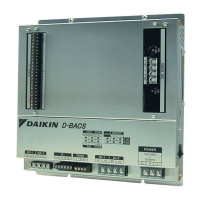1.5 Open Network Glossary xv
Introduction
Term Explanation
SE S
ystem Engineer
System Engineer (SE) is a generic term used in the computer industry to refer to engineers who install
computers and communications devices for end-users. System engineers also generally confirm proper
operation of OS (operating software) and AS (application software) after set up. These capabilities are, of
course, necessary in the case of a BAS, but unlike the so-called computer systems, the SE must also
determine necessary specifications in order for vendors to manufacture systems that can effectively realize
functions and achieve desired performance levels detailed on the provided drawings. In addition, appropriate
instruction to and/or coordination between related parties, such as departments that design and create
hardware and software, according to the pertinent process as well as the promotion of smooth system
configurations are also responsibilities of the SE.
Selecting When a control station (central monitoring panel) sends data to a tributary station (DMS II or Interface for
LONWORKS
®
), a message is first sent to the latter to check if the data can be received. The data is then
sent upon receipt of an affirmative response from the tributary station (indicating that the data can be
received).
SI S
ystem Integrator
System Integrator (SI) is a generic term used in the computer industry to refer not only to the work of selecting
hardware and software suited to configured computer systems, setting up networks and altering software to
accompany the systems to be installed but also to the companies/engineers who perform the work. BASs,
including building management systems, represent a type of computer system, so the responsibilities of an
SI are the same. In addition, the responsibilities of the SI also include: a thorough understanding of functions
and features of the targeted electric equipment, A/C system and the like; coordination between hardware,
software and network designs provided by a multiple number of vendors; and smooth configuring of systems
to meet the objectives within a predetermined cost in cooperation with design supervisors and BA orderers.
Single Vendor Refers to a situation involving only one vendor or manufacturer.
SNVT S
tandard Network Variable Types
Refers to the variables used to control A/C units within LONs. These variables have been established by the
The Japan Refrigeration and Air Conditioning Industry Association (JRAIA) and are the standard variables in
Japan.
They are the equivalent of codes for control and monitoring items that enable interoperability in LONs.
(Predefined objects)
TCP-IP T
ransmission Control Protocol/Internet Protocol
TCP-IP is a standard protocol supported in all OS such as UNIX, an OS used in mid- to large-sized
computers, Windows and Mac.
TCP-IP was designed by an organization associated with the U.S. Department of Defense to allow for
communications between computers through another route even if a part or parts of a network were
destroyed.
Topology Refers to the connection arrangement within a network. Equivalent to the wiring method in DIII-NET. Star and
bus are some examples of topologies.
Unicast Refers to the sending of messages only to specified devices.
Specifically, it is the sending of messages between devices connected in a network on a one-to-one basis.
Unit Minimum unit of indoor unit or outdoor unit: One indoor unit shall be assumed to be one unit, and one outdoor
unit with refrigerating cycle shall be assumed to be one unit.
UNVT U
ser-defined Network Variable Types
Refer to the variables used to control A/C units within LONs. They are determined according to specific
projects (buildings, etc.) and, thus, are usually not used.
Vendor The seller or manufacturer
XIF File Refers to a file comprised of data containing network variables for LON nodes. The company manufacturing
the node (in this case, Daikin) creates the file and submits it to the NI upon receipt of an order for a system.
Zone A specified air-conditioning area that requires the same control in a building.

